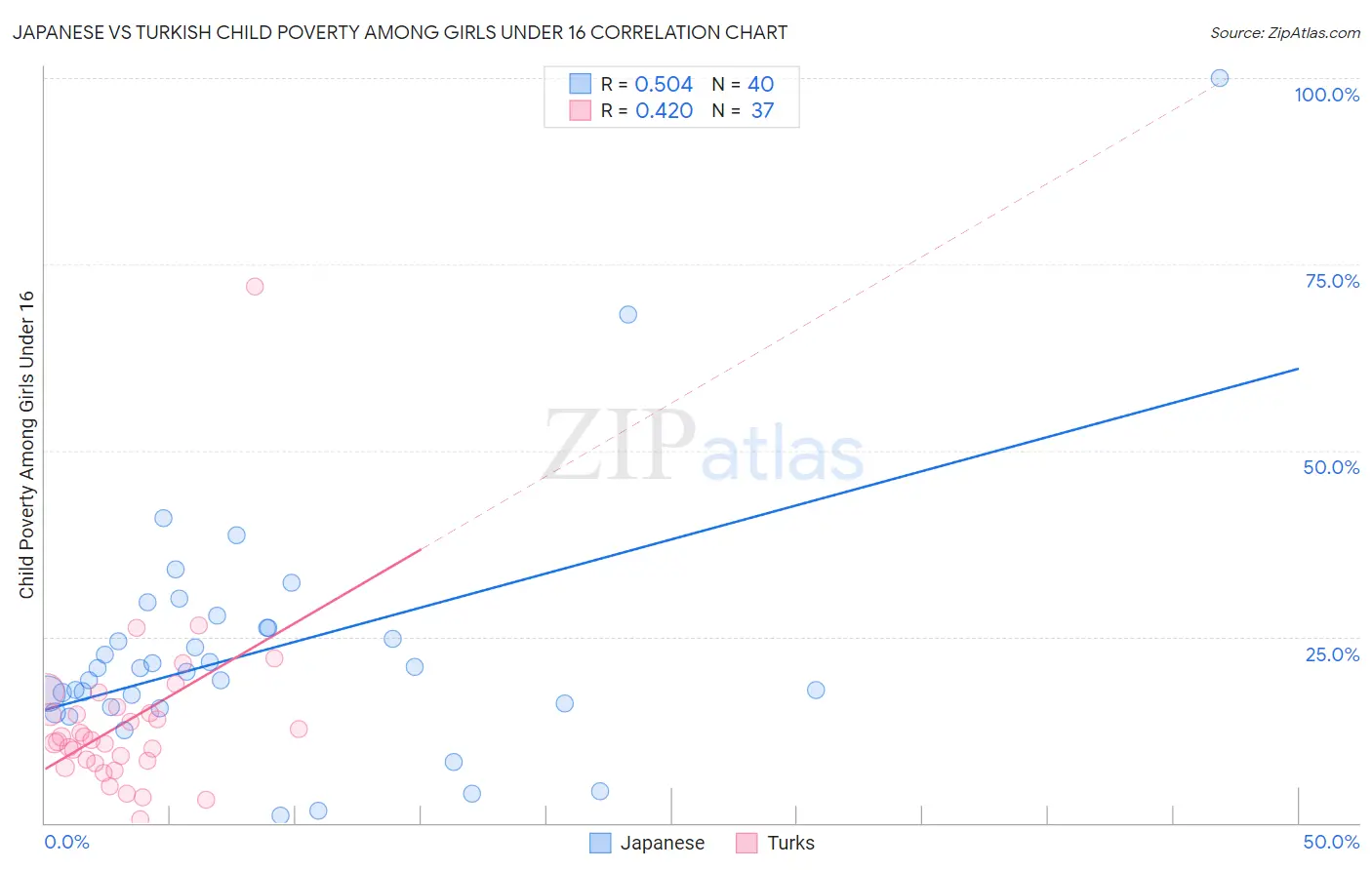Japanese vs Turkish Child Poverty Among Girls Under 16
COMPARE
Japanese
Turkish
Child Poverty Among Girls Under 16
Child Poverty Among Girls Under 16 Comparison
Japanese
Turks
17.8%
CHILD POVERTY AMONG GIRLS UNDER 16
5.3/ 100
METRIC RATING
217th/ 347
METRIC RANK
13.7%
CHILD POVERTY AMONG GIRLS UNDER 16
99.7/ 100
METRIC RATING
31st/ 347
METRIC RANK
Japanese vs Turkish Child Poverty Among Girls Under 16 Correlation Chart
The statistical analysis conducted on geographies consisting of 247,332,708 people shows a substantial positive correlation between the proportion of Japanese and poverty level among girls under the age of 16 in the United States with a correlation coefficient (R) of 0.504 and weighted average of 17.8%. Similarly, the statistical analysis conducted on geographies consisting of 267,627,928 people shows a moderate positive correlation between the proportion of Turks and poverty level among girls under the age of 16 in the United States with a correlation coefficient (R) of 0.420 and weighted average of 13.7%, a difference of 30.2%.

Child Poverty Among Girls Under 16 Correlation Summary
| Measurement | Japanese | Turkish |
| Minimum | 1.0% | 0.50% |
| Maximum | 100.0% | 71.9% |
| Range | 99.0% | 71.4% |
| Mean | 23.2% | 13.5% |
| Median | 20.5% | 11.2% |
| Interquartile 25% (IQ1) | 15.8% | 8.2% |
| Interquartile 75% (IQ3) | 26.2% | 15.1% |
| Interquartile Range (IQR) | 10.4% | 6.9% |
| Standard Deviation (Sample) | 17.1% | 11.5% |
| Standard Deviation (Population) | 16.9% | 11.4% |
Similar Demographics by Child Poverty Among Girls Under 16
Demographics Similar to Japanese by Child Poverty Among Girls Under 16
In terms of child poverty among girls under 16, the demographic groups most similar to Japanese are Moroccan (17.8%, a difference of 0.090%), Alaska Native (17.8%, a difference of 0.10%), Malaysian (17.8%, a difference of 0.19%), German Russian (17.8%, a difference of 0.19%), and Pennsylvania German (17.8%, a difference of 0.21%).
| Demographics | Rating | Rank | Child Poverty Among Girls Under 16 |
| Immigrants | Immigrants | 7.3 /100 | #210 | Tragic 17.7% |
| Immigrants | Eastern Africa | 6.4 /100 | #211 | Tragic 17.7% |
| Immigrants | Thailand | 6.3 /100 | #212 | Tragic 17.7% |
| Pennsylvania Germans | 5.7 /100 | #213 | Tragic 17.8% |
| Malaysians | 5.7 /100 | #214 | Tragic 17.8% |
| German Russians | 5.7 /100 | #215 | Tragic 17.8% |
| Moroccans | 5.5 /100 | #216 | Tragic 17.8% |
| Japanese | 5.3 /100 | #217 | Tragic 17.8% |
| Alaska Natives | 5.2 /100 | #218 | Tragic 17.8% |
| Immigrants | Panama | 4.7 /100 | #219 | Tragic 17.9% |
| Cubans | 4.1 /100 | #220 | Tragic 18.0% |
| Immigrants | Micronesia | 3.5 /100 | #221 | Tragic 18.0% |
| Immigrants | Cambodia | 2.9 /100 | #222 | Tragic 18.1% |
| Immigrants | Armenia | 2.9 /100 | #223 | Tragic 18.1% |
| Bermudans | 2.8 /100 | #224 | Tragic 18.1% |
Demographics Similar to Turks by Child Poverty Among Girls Under 16
In terms of child poverty among girls under 16, the demographic groups most similar to Turks are Danish (13.7%, a difference of 0.040%), Swedish (13.7%, a difference of 0.070%), Asian (13.7%, a difference of 0.12%), Maltese (13.7%, a difference of 0.13%), and Bolivian (13.6%, a difference of 0.79%).
| Demographics | Rating | Rank | Child Poverty Among Girls Under 16 |
| Immigrants | Eastern Asia | 99.9 /100 | #24 | Exceptional 13.4% |
| Immigrants | China | 99.8 /100 | #25 | Exceptional 13.4% |
| Eastern Europeans | 99.8 /100 | #26 | Exceptional 13.5% |
| Latvians | 99.8 /100 | #27 | Exceptional 13.5% |
| Tongans | 99.8 /100 | #28 | Exceptional 13.6% |
| Bolivians | 99.8 /100 | #29 | Exceptional 13.6% |
| Asians | 99.7 /100 | #30 | Exceptional 13.7% |
| Turks | 99.7 /100 | #31 | Exceptional 13.7% |
| Danes | 99.7 /100 | #32 | Exceptional 13.7% |
| Swedes | 99.7 /100 | #33 | Exceptional 13.7% |
| Maltese | 99.7 /100 | #34 | Exceptional 13.7% |
| Immigrants | Northern Europe | 99.6 /100 | #35 | Exceptional 13.8% |
| Russians | 99.6 /100 | #36 | Exceptional 13.9% |
| Lithuanians | 99.6 /100 | #37 | Exceptional 13.9% |
| Immigrants | Moldova | 99.6 /100 | #38 | Exceptional 13.9% |